Arctic voyage finds global warming impact on ice, animals
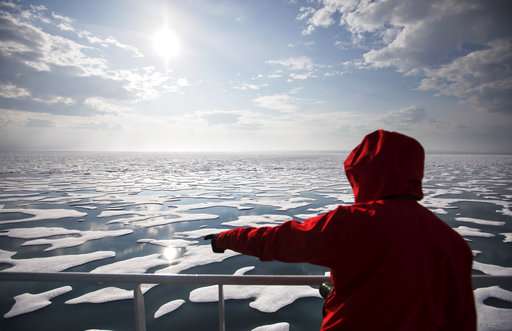
The email arrived in mid-June, seeking to explode any notion that global warming might turn our Arctic expedition into a summer cruise.
"The most important piece of clothing to pack is good, sturdy and warm boots. There is going to be snow and ice on the deck of the icebreaker," it read.
The Associated Press was joining international researchers on a month-long, 10,000 kilometer (6,200-mile) journey to document the impact of climate change on the forbidding ice and frigid waters of the Far North. But once the ship entered the fabled Northwest Passage between the Atlantic and the Pacific, there would be nowhere to stop for supplies and no help for hundreds of miles. So in went the boots: Global warming or not, it was best to come prepared.
If parts of the planet are becoming like a furnace because of global warming, then the Arctic is best described as the world's air-conditioning unit. The frozen north plays a crucial role in cooling the rest of the planet while reflecting some of the sun's heat back into space.
But it, too, is beginning to overheat. Last year was the hottest on record in the Arctic. And for several decades, satellite pictures have shown a dramatic decline in Arctic sea ice that is already affecting the lives of humans and animals in the region, from Inuit communities to polar bears.
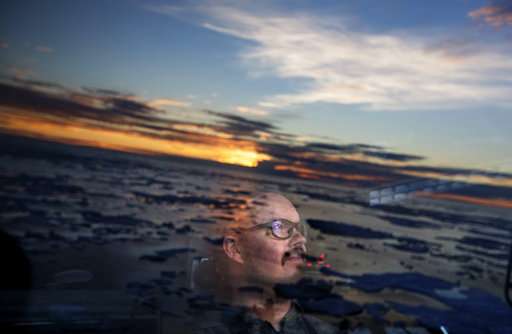
Scientists say sea ice will largely vanish from the Arctic during the summer within the coming decades. Experts predict that the impact of the melting ice will be felt across the northern hemisphere as far as Florida or France.
"Things are changing in the Arctic, and that is changing things everywhere else," said David 'Duke' Snider, the seasoned mariner responsible for navigating the Finnish icebreaker MSV Nordica.
Researchers on the trip sought a first-hand view of the effects of global warming already seen from space. The ship departed Vancouver in early July and arrived in Nuuk, Greenland on July 29th, the earliest transit ever of a region that isn't usually navigable until later in the year because of ice.
Twelve days after the ship had left Vancouver, the ice appeared out of nowhere.
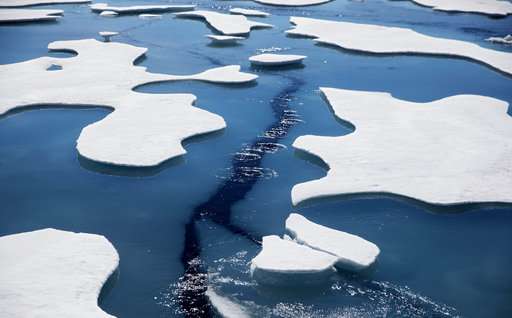
At first, lone floes bobbed on the waves like mangled lumps of Styrofoam. By the time Nordica reached Point Barrow, on Alaska's northernmost tip, the sea was swarming with ice.
Snider recalled that when he started guiding ships through Arctic waters more than 30 years ago, the ice pack in mid-July would have stretched 50 miles farther southwest. Back then, a ship also would have encountered much thicker, blueish ice that had survived several summer melts, becoming hard as concrete in the process, he said. He likened this year's ice to a sea of porridge with a few hard chunks.
The outdoor thermometer indicated a temperature of 47 degrees Fahrenheit (8.3 Celsius), but in the never-setting sun of an Arctic summer it felt more like 60 F. Days blurred into nights. Even in their bunks, those on board heard the constant churning of ice as the ship plowed through the debris rolling beneath the hull, thundering like hail on a tin roof.
As the icebreaker entered Victoria Strait, deep inside the Northwest Passage, we looked for a shadow moving in the distance or a flash of pale yellow in the expanse of white that would signal the presence of the world's largest land predator.
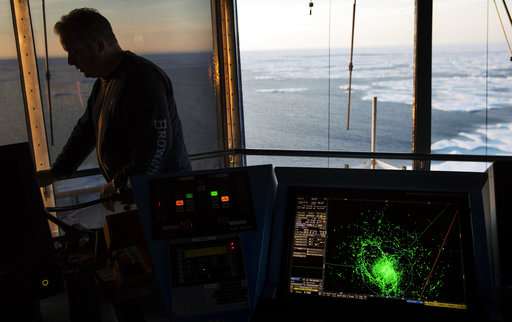
At last, a cry went out: "Nanuq, nanuq!"
Maatiusi Manning, an Inuit sailor, had spotted what everyone on board was hoping to see—the first polar bear.
The 1,000-pound predators are at the top of a food chain that's being pummeled by global warming because of the immediate impact vanishing sea ice has on a range of animals and plants that depend on it.
"If we continue losing ice, we're going to lose species with it," said Paula von Weller, a field biologist who was on the trip.
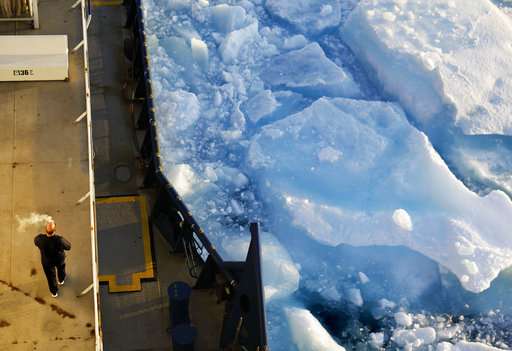
No Arctic creature has become more associated with climate change than the polar bear, the poster child of Arctic wildlife. The U.S. Fish and Wildlife Service estimated in January that about 26,000 specimens remain in the wild, and warned that melting sea ice is robbing the bear of its natural hunting ground for seals and other prey.
While some polar bears are expected to follow the retreating ice northward, others will head south, where they will come into greater contact with humans—encounters that are unlikely to end well for the bears.
Some of the animals highly associated with the ice are not going to be able to adapt in a reasonable amount of time to keep up with climate change, Weller said.
"The walrus, for example, may spend more time on the mainland. They're very prone to disturbance so that's not a good place for walrus to be," said von Weller.
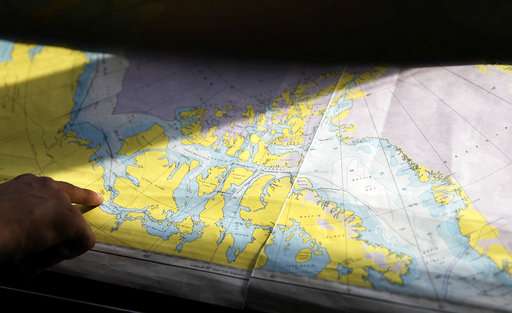
Research published four years ago rang alarms bells about the future of the red king crab—a big earner for Alaska's fishing industry—because rising levels of carbon dioxide, a driver of global warming, are making oceans more acidic. Algae that cling to the underside of sea ice are also losing their habitat. If they vanish, copepods, a type of zooplankton that eats algae, will lose their source of food, and the tiny crustaceans in turn are prey for fish, whales and birds.
Meanwhile, as waters warm, orca are traveling further north in search of food. Some wildlife experts predict they will become the main seal predator in the coming decades, replacing polar bears.
Humans are also increasingly venturing into the Arctic in search of untapped deposits of minerals and fossil fuels, and the potential for oil spills is a major cause for concern among environmentalists. The Inuit people in the Clyde River community of Baffin Island also fear that the loud underwater noise caused by seismic blasts of oil companies could disorient marine mammals such as whales and affect the reproductive cycles of fish and shrimp stocks.
However, some say the absence of sea ice for longer periods each summer is not all bad: Boats can supply villages and mines for longer periods of the year.
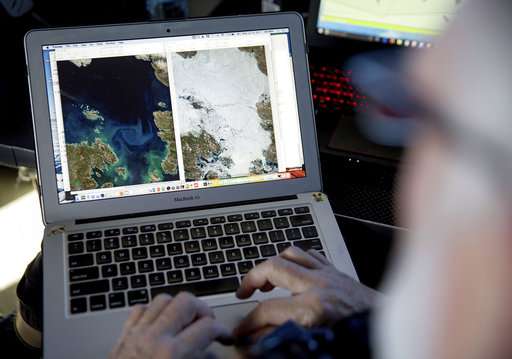
Nordica reached Nuuk, the capital of Greenland, after 24 days.
And in the end, we did get a taste of the warming Arctic: Those heavy, fur-lined boots never got used.
-
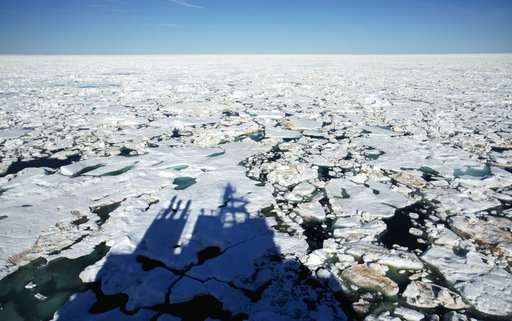
The Finnish icebreaker MSV Nordica casts a shadow on the ice while traversing the Northwest Passage through the Victoria Strait in the Canadian Arctic Archipelago Friday, July 21, 2017. If parts of the planet are becoming like a furnace because of global warming, then the Arctic is best described as the world's air-conditioning unit. The frozen north plays a crucial role in cooling the rest of the planet while reflecting some of the sun's heat back into space. Yet for several decades, satellite pictures have shown a dramatic decline in Arctic sea ice that is already affecting the lives of humans and animals in the region. Experts predict that the impact of melting sea ice will be felt across the northern hemisphere, altering ocean currents and causing freak weather as far south as Florida or France. (AP Photo/David Goldman) -
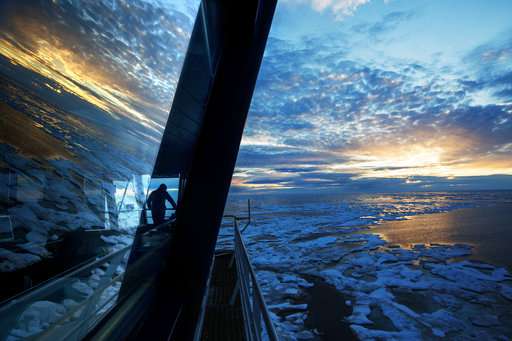
Nigel Greenwood, assistant ice navigator, looks out at the ice from the bridge while standing watch overnight aboard the Finnish icebreaker MSV Nordica as it traverses the Northwest Passage in the Canadian Arctic Archipelago, Friday, July 21, 2017. Modern mariners can get daily satellite snapshots of the ice and precise GPS locations that help them dodge dangerous shallows. But technology can be fickle. After two weeks at sea the ship's fragile internet connection went down for six days: no emails, no Google, no new satellite pictures to preview the route ahead. (AP Photo/David Goldman) -
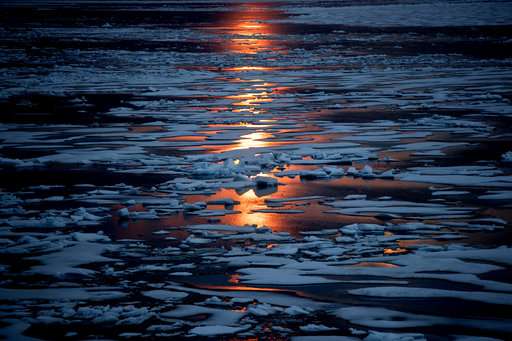
The midnight sun shines across sea ice along the Northwest Passage in the Canadian Arctic Archipelago, Sunday, July 23, 2017. The melting ice is one reason why modern ships have an easier time going through the Northwest Passage, 111 years after Norwegian adventurer Roald Amundsen achieved the first transit. Early explorers found themselves blinded by harsh sunlight reflecting off a desert of white, confused by mirages that give the illusion of giant ice cliffs all around, and thrown off course by the proximity of the North Pole distorting their compass readings. (AP Photo/David Goldman) -
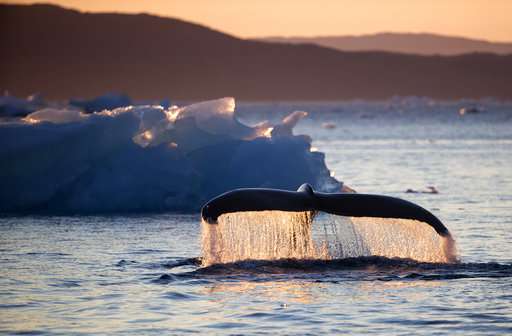
A humpback whale dives while swimming in the Nuup Kangerlua Fjord near Nuuk in southwestern Greenland, Tuesday, Aug. 1, 2017. People are so far removed from the Arctic that they don't understand it, they don't know it and they don't love it," said Paula von Weller, a field biologist. "I think it's important for people to see what's here and to fall in love with it and have a bond and want to protect it." (AP Photo/David Goldman) -
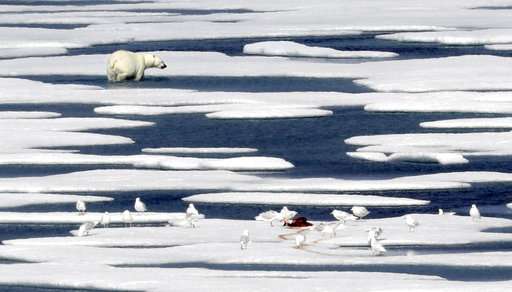
A polar bear walks away after feasting on the carcass of a seal on the ice in the Franklin Strait in the Canadian Arctic Archipelago, Saturday, July 22, 2017. No Arctic creatures have become more associated with climate change than polar bears. The U.S. Fish and Wildlife Service estimated in January that about 26,000 specimens remain in the wild. (AP Photo/David Goldman) -
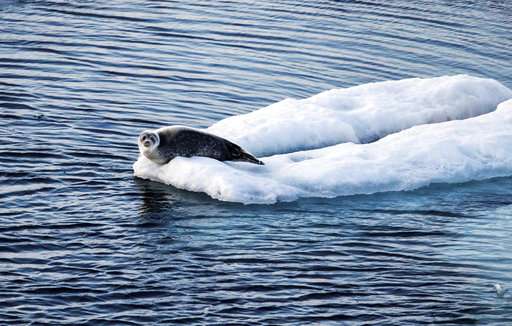
A seal sits on sea ice floating in the Victoria Strait in the Canadian Arctic Archipelago, Friday, July 21, 2017. "People are so far removed from the Arctic that they don't understand it, they don't know it and they don't love it," said Paula von Weller, a field biologist who was on the trip. "I think it's important for people to see what's here and to fall in love with it and have a bond and want to protect it." (AP Photo/David Goldman) -
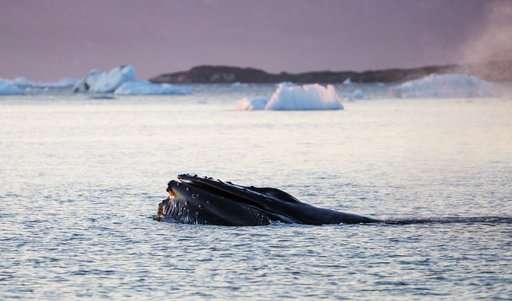
The mouth of a humpback whale emerges while swimming in the Nuup Kangerlua Fjord near Nuuk in southwestern Greenland, Tuesday, Aug. 1, 2017. Algae that cling to the underside of sea ice are losing their habitat. If they vanish, the impact will be felt all the way up the food chain. Copepods, a type of zooplankton that eats algae, will lose its source of food. The tiny crustaceans in turn are prey for fish, birds and whales. (AP Photo/David Goldman) -
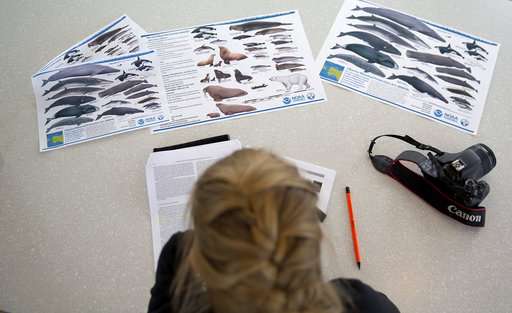
Researcher Tiina Jaaskelainen looks over information sheets on marine mammals of the North Pacific and Arctic aboard the Finnish icebreaker MSV Nordica as it sails the North Pacific Ocean to traverse the Northwest Passage through the Canadian Arctic Archipelago Saturday, July 8, 2017. "If we continue losing ice, we're going to lose species with it," said Paula von Weller, a field biologist who was on the trip. (AP Photo/David Goldman) -
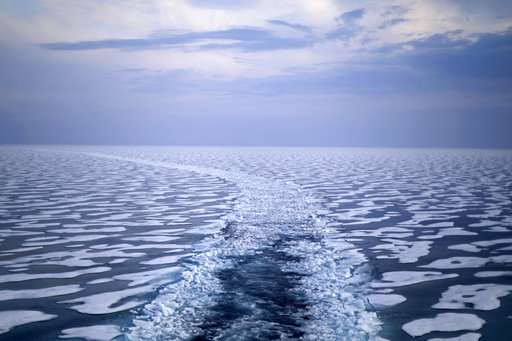
A path in the ice is left in the wake of the Finnish icebreaker MSV Nordica as it traverses the Northwest Passage through the Franklin Strait in the Canadian Arctic Archipelago Saturday, July 22, 2017. Researchers on the trip sought to observe the changes taking place in the region first hand, to gain a clearer picture of the effects of global warming already seen from space. Even the dates of the journey were a clue: The ship departed Vancouver in early July and arrived in Nuuk, Greenland on July 29th, the earliest transit ever of a region that isn't usually navigable until later in the year. (AP Photo/David Goldman) -
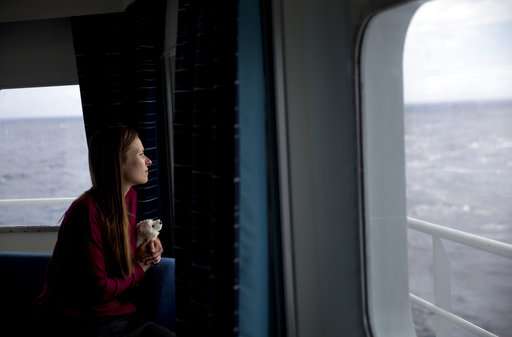
Researcher Daria Gritsenko holds her stuffed polar bear, Umka, while looking out from the Finnish icebreaker MSV Nordica as it sails the North Pacific Ocean to traverse the Northwest Passage through the Canadian Arctic Archipelago Monday, July 10, 2017. As the icebreaker entered deep inside the Northwest Passage, those onboard looked for a shadow moving in the distance or a flash of pale yellow in the expanse of white that would signal the presence of the world's largest land predator. (AP Photo/David Goldman) -
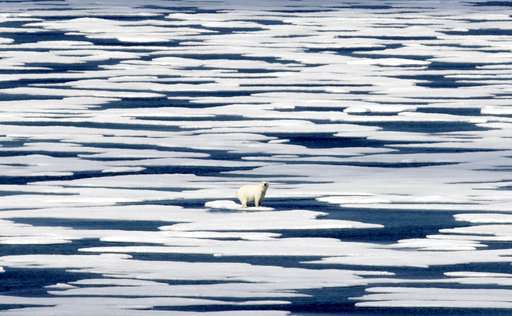
A polar bear stands on the ice in the Franklin Strait in the Canadian Arctic Archipelago, Saturday, July 22, 2017. While some polar bears are expected to follow the retreating ice northward, others will head south, where they will come into greater contact with humans, encounters that are unlikely to end well for the bears. (AP Photo/David Goldman) -

Trainee Maatiusi Manning tries to video chat with his family aboard the Finnish icebreaker MSV Nordica as it traverses the Northwest Passage through the Canadian Arctic Archipelago Wednesday, July 26, 2017. After two weeks at sea the ship's fragile internet connection went down for six days: no emails, no new satellite pictures to preview the route ahead. (AP Photo/David Goldman) -
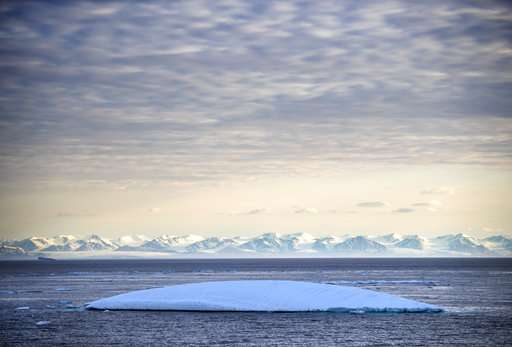
An iceberg floats past Bylot Island in the Canadian Arctic Archipelago, Monday July. 24, 2017. If parts of the planet are becoming like a furnace because of global warming, then the Arctic is best described as the world's air-conditioning unit. The frozen north plays a crucial role in cooling the rest of the planet while reflecting some of the sun's heat back into space. (AP Photo/David Goldman) -
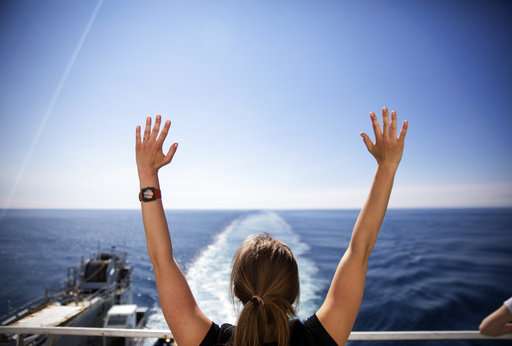
Daria Gritsenko stretches while doing yoga in the warm weather aboard the Finnish icebreaker MSV Nordica as it sails the Bering Sea to traverse the Northwest Passage through the Canadian Arctic Archipelago Thursday, July 13, 2017. As it made its way through the North Pacific, passing Chinese cargo ships, Alaskan fishing boats and the occasional far-off whale, members of the expedition soaked up the sun in anticipation of freezing weeks to come. (AP Photo/David Goldman) -
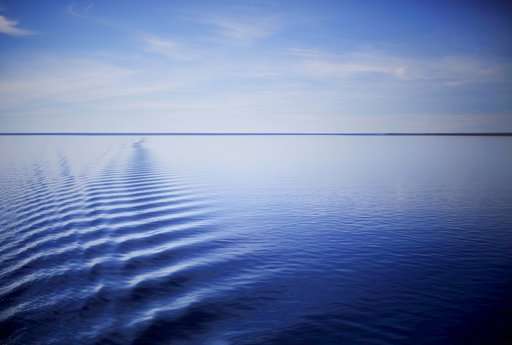
Waves form on a tranquil sea in the wake of the Finnish icebreaker MSV Nordica as it traverses the Northwest Passage through the Canadian Arctic Archipelago, Thursday, July 20, 2017. Canadian ice navigator, David "Duke" Snider recalled that when he started guiding ships through Arctic waters more than 30 years ago, the ice pack in mid-July would have stretched 50 miles farther southwest. Back then a ship would also have encountered much thicker, blueish ice that had survived several summer melts, becoming hard as concrete in the process, he said. (AP Photo/David Goldman) -
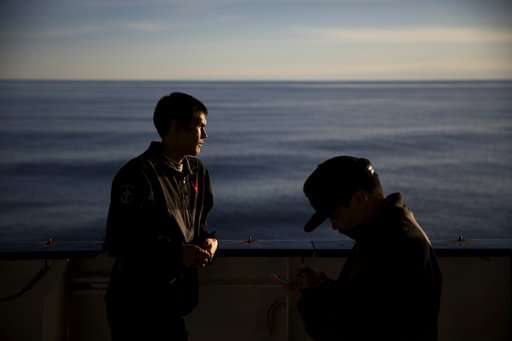
Trainee David Kullualik, left, and Maatiusi Manning, both part of Canada's indigenous Inuit community, stand on the deck of the MSV Nordica as it traverses the Northwest Passage through Lancaster Sound in the Canadian Arctic Archipelago, Friday, July 28, 2017. Kullualik has spent time with his family hunting on the islands in the area where his grandparents grew up. "I was imagining how my grandpa used to live, what they used to go through" Kullualik said of the remote lands the boat past through. "I felt a connection all the way through." (AP Photo/David Goldman)
© 2017 The Associated Press. All rights reserved.


















